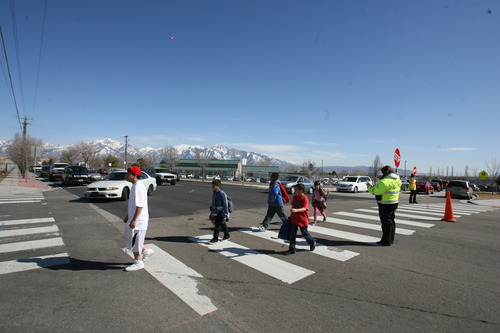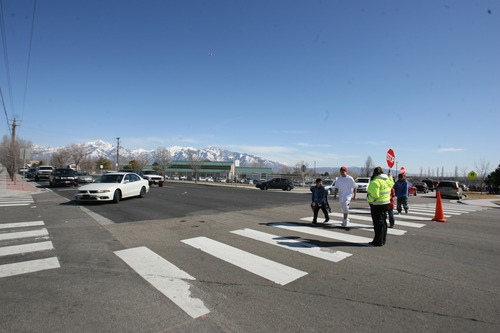This is an archived article that was published on sltrib.com in 2013, and information in the article may be outdated. It is provided only for personal research purposes and may not be reprinted.
The four-lane 6200 South is constantly busy in front of Westbrook Elementary, just east of Bangerter Highway. The heavy traffic makes life a bit dangerous for students and tricky for residents trying to turn into or out of nearby neighborhoods without traffic lights to help.
"Improving the safety of the elementary students is at the top of our list," says Taylorsville City Engineer John Taylor. "It is very important to us."
So Taylorsville officials successfully lobbied the Legislature this year for $4.2 million to make improvements there, including adding a school pedestrian overpass and an interchange with a signal to improve access to now-vacant land expected to develop soon while helping adjacent subdivisions.
Several other local governments, including West Valley City, also lobbied lawmakers for special help on projects and received it — but not before several top state leaders complained loudly.
They worry that political earmarks may unfairly help the well-connected, instead of relying on traditional, nonpolitical prioritization of statewide needs by the Utah Transportation Commission, or letting cities simply live with the share of state road funds that formulas give them.
One who complained was House Speaker Becky Lockhart, R-Provo. She was the only House member to vote against HB377, which passed 72-1 and gift wrapped millions of dollars in money borrowed through bonding for earmarked local projects.
Among projects included from the Valley West area were the 6200 South improvements, $300,000 for a pedestrian/bike tunnel under I-215 at about 5100 South, $4.3 million for work to begin connecting separated segments of 2400 South between 4800 and 7200 West, and $700,000 for a new pedestrian bridge across the Jordan River near West Valley City's Cultural Celebration Center.
"I am personally getting a little tired of this directing the Transportation Commission what to do, as opposed to leaving it up to them," Lockhart told The Tribune after the House vote. She added that rules prohibited her as the presiding officer to speak out during debate, and she worried that too many members did not fully realize what the bill did.
HB377 later passed 18-9 in the Senate — where Executive Appropriations Committee Chairman Lyle Hillyard, R-Logan, also complained about it, saying it even earmarked money for things such as sidewalks in Park City. "I talked to several members of the House. They had no idea what was in the bill. It was presented quickly and went through."
He added, "We have a state Transportation Commission, and [it] should make the decision for the money" instead of providing earmarks.
Sen. Daniel Thatcher, R-West Valley City, was among the handful of senators opposing the measure.
Concerns that the well-connected are treated too well came as nearly two-thirds of the money added to HB377 for specifically named projects will go to cities or local governments represented by just three lobbyists: former House Speaker Greg Curtis, Rob Jolley and Dave Stewart (who has West Valley City among his clients).
Among $41.45 million in earmarks in the bill were a variety of projects in Bluffdale, Cottonwood Heights, Draper, Herriman, Midvale, Murray, Ogden, Sandy, South Jordan, Tooele and West Jordan. The bill also did things such as provide millions for a Utah Transit Authority study of transportation in canyons, and $3 million for a study of how to improve transportation in the Uinta Basin.
Besides HB377, some separate appropriations requests for earmarks also caused some heartburn at the Legislature.
Its Infrastructure and General Government Appropriations Committee was the first to hear requests for state transportation money for several projects including the I-215 pedestrian underpass in Taylorsville and the Jordan River pedestrian bridge in West Valley City — both of which later became part of HB377 to instead receive money from bonding.
UDOT Executive Director John Njord said in an interview at that committee's hearing that UDOT had been reminding members that state transportation money is supposed to go to highways, and it was concerned that earmarks for things such as park pedestrian bridges might be straying too far.
Amid that, the committee co-chairmen, Sen. Wayne Harper, R-Taylorsville, and Rep. Gage Froerer, R-Huntsville, announced they had decided that if members decided to fund any such requested projects in appropriations bills, money would come from general funds instead of transportation funds.
Sen. Stuart Adams, R-Layton, a former chairman of the Utah Transportation Commission, was among those who requested an earmark for the I-215 pedestrian tunnel in Taylorsville and defended such earmarks.
"Sometimes formulas used by the transportation commission to determine priorities do not really measure very well the social need of some projects to a small, local community," so he said it is wise to allow limited earmarking to help them. He said the commission even tries to allow each of UDOT's regions some discretionary money to fund a few such locally important projects when they arise.
Sen. Karen Mayne, D-West Valley City, who also pushed the I-215 pedestrian tunnel, defended that earmark in Senate debate. "This is vital to Taylorsville," she said, noting I-215 separated some neighborhoods and even church congregations. "It's really difficult for us in this small community to move around, and this connects two vital areas in our city and we really need this. If we don't feed communities, they will starve."
Current Transportation Commission Chairman Jeff Holt says he would prefer that all projects go through its review process because its formulas slice through politics to ensure that the most-needed projects are funded first. He says he does not mind a few earmarks — "as long as it doesn't get out of hand."
Twitter: @LeeHDavidson









